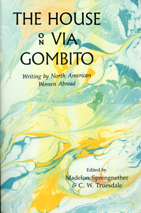The Protestant Cemetery in its own Piazalle Donatello lies outside the walls in Florence, meaning that when it was first established in the early 1800s, it could not be situated on sacred ground within the city walls. Though certainly Christian, its Swiss founders were not Catholic, thus they and the dead they housed–Americans, English, Russians, Swiss–were “beyond the pale,” given a rise of ground taller at one end, closer to level at the other, just outside the Borgo Pinto gate. Some old maps suggest that this odd-shaped ground was created by centuries of dumping garbage over the wall, with one side of the dump rising almost to the top of the wall.
These days, with the wall dismantled, two streams of almost constant traffic surge on either side of this odd-shaped piece of earth. You must press the “pedestrian crossing” button to bring traffic to a halt and cross to this beautiful island of the dead, with its stands of graceful cypress, and dotted plantings of white marble.
Ring the bell at the iron gate and it sounds inside the gatehouse, a low simple building with arched entryway where horses used to draw up the bodies. Today, burials no longer occur in the Protestant Cemetery, but visitors abound; the cemetery is a monument, cared for today by two custodians, two wonderful “sisters,” one Italian-born and trained, the other, Sister Julia Holloway, a British academic-turned Anglican nun, who recently converted to Catholicism. There could not be a more hearty welcome to visitors than offered by Sister Julia in her flowing grey gown with white scarf around her smiling face.
When I first visited the cemetery in the early 2000s, Sister Julia was recently arrived herself: she had worked as custodian at the Elizabeth Barrett and Robert Browning house, Casa Guidi, across the Arno near the Pitti Palace. Since she and her father had edited a new edition (Penguin 1996) of Elizabeth Barrett Browning’s novel-like poem, Aurora Leigh, Sister Julia’s association with Casa Guidi perfectly fit her passion. Now she is passionate about the Protestant Cemetery, working hard to restore the tombs and their iron-work, remove diseased cypress and have the city replant new ones.
The sloping, narrow ground of the cemetery leads the visitor away from the entry, along a wide, stepped path. The graves are ranged in irregular rows away from the main path, with those to the right on ground that drops off precipitously to an iron fence, and from there to whizzing cars. My first visit, I didn’t have to stray from the core path to find two graves that stopped me in my tracks. The first was Elizabeth Barrett Browning’s, standing on four small columns, presenting its side to the passer-by. There along the bottom were the initials “E.B.B” and a narrow runner of her dates: 1806-61. According to Sister Julia, the medallion profile in the center of the tomb is not of EBB herself, but a rendition of laurel-wreathed Corrine, the heroine of Madame de Stael’s novel. I prefer to imagine it’s the poet whose lies there.
Further up the main path, I was stopped by another, simpler grave in grey “pietra serena,” the local quarried stone used by Brunelleschi and many other Renaissance artists in their serene churches–enter the church of Santo Spirito, also across the Arno, and you’ll see what I mean. This tomb also has its enigmas: “Libby” was scrawled across it. Then below: “Elizabeth Russell Jarves, wife of James Jackson Jarves, Boston, died 1861.” Along with the inscription was carved a pansy, flower of love and longing. Pursuing the Libby’s history has fascinated me for almost a decade now: I’m well into writing a novel about her very peculiar life. But what life isn’t peculiar, especially those of travelers to Florence who had the misfortune or fortune to die there and be buried in the English Cemetery?
Sister Julia has wrought enormous benefits for the cemetery since I first visited: she is working to have it declared a UNESCO World Heritage site, which it surely should be. She has hired the people called Roma, whom we in the U.S. rather too casually call gypsies, to help repair tombs and ironwork, arguing that these people, often spat-upon and burned out of their camps, are excellently trained in such repair and will do it gladly for far less than local Florentine artisans.
Not only this, but she has made the cemetery’s presence in cyber space full and accessible. Her researcher’s impulse to collect and document, to publish and disseminate, and her skills with loading photographs and text onto the Web–all have made the English Cemetery a presence on the world stage, which it was not at all when I first visited.
Especially for American and English tourists, I can’t imagine a more restful, yet inspiring spot that standing among the spears of cypress and contemplating Florentine soil which houses the ghosts of many great writers from almost two centuries ago. Plus you’ll have the charm and education of meeting Sister Julia: if a cemetery can be a classroom, she has found her academy.


Leave a Reply